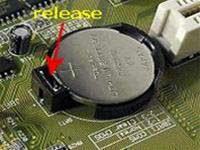 Setting a CMOS password is considered one of the effective measures for securing a computer. Breaking a CMOS password can be quite challenging, but it is not impossible. However, successfully doing so requires a certain level of skill.
Setting a CMOS password is considered one of the effective measures for securing a computer. Breaking a CMOS password can be quite challenging, but it is not impossible. However, successfully doing so requires a certain level of skill.
There are several methods to bypass a CMOS password, such as replacing the BIOS chip, interrupting the BIOS chip circuit, using a jumper, removing the battery from the motherboard, using specific commands, or entering the default passwords set by the manufacturer. For those of us with basic technical knowledge, the following two methods may be applicable.
1. Entering Default BIOS Passwords Provided by the Manufacturer.
– For Award BIOS, you can try entering the following default passwords to unlock a previously set password: AWARD SW, AWARD_SW, Award SW, AWARD PW, _award, awkward, J64, j256, j262, j332, j322, 01322222, 589589, 589721, 595595, 598598, HLT, SER, SKY_FOX, aLLy, aLLY, Condo, CONCAT, TTPTHA, aPAf, HLT, KDD, ZBAAACA, ZAAADA, ZJAAADC, djonet.
– For Ami BIOS, you can try: AMI, A.M.I., AMI SW, AMI_SW, BIOS, PASSWORD, HEWITT RAND, Oder.
– Some common passwords for Ami, Award, and other BIOS types that you can attempt include: LKWPETER, lkwpeter, BIOSTAR, biostar, BIOSSTAR, biosstar, ALFAROME, Syxz, Wodj.
However, this method may not be very effective since there are many other BIOS brands besides Award and Ami, and we often cannot determine their default passwords.
2. Bypassing the CMOS Password Using Specialized Software or Commands in DOS:
If you have access to a computer with a CMOS password set, you can use some DEBUG commands in the DOS environment to remove the password. These commands can disable the BIOS memory, restoring it to its original state, i.e., before the password was set. However, this can also be quite difficult because accessing the DEBUG environment is not always possible.
A more effective method is to visit http://www.cgsecurity.org/cmospwd-4.8.zip to download a tool called “Cmos Password Recovery Tools 4.8”. -> Extract the file -> Navigate to the Windows folder -> Launch the file cmospwd_win.exe to automatically clear the current BIOS memory. If you’re lucky, the next startup will have no BIOS password. For added assurance, you should also go to the “DOS” folder and run the file cmospwd.exe once more.
3. Completely Removing the Motherboard Battery to Erase the BIOS Memory.
This hardware action is considered the most effective way to completely erase the BIOS memory, and if you’re a bit daring, anyone can do it.
First, you need to open the computer case -> Carefully inspect the motherboard to locate a battery roughly the size of a 200-coin, fitted into a circular slot. Finding this battery is not too difficult -> Observe carefully and remove the battery by pressing down on the “jumper” as illustrated -> Take the battery out and wait about 30 minutes for good measure, ensuring all data stored in the BIOS will evaporate -> then reinsert it as illustrated. When you restart the computer, the BIOS will automatically revert to its original default settings, and naturally, the password will be gone.
In most cases, removing the battery is successful; however, if you reinsert the battery and the password remains, you may need to remove it again and wait longer, possibly even a whole day, for the data to evaporate.
THUY KHANH (Compiled)


















































